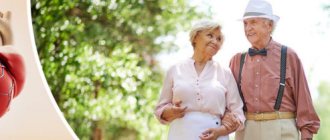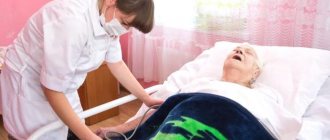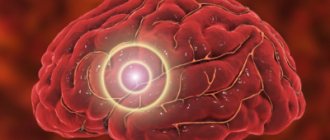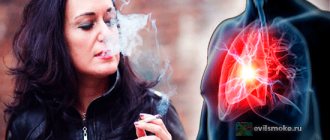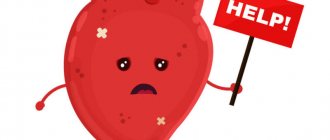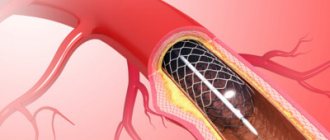Rehabilitation after a myocardial infarction can take several months, but without it, returning to your normal lifestyle and avoiding recurrence of attacks is extremely difficult. Initial work should be carried out during the recovery stage, when the patient is in the hospital, and subsequent work can be successfully carried out both in a specialized boarding house and at home. Throughout this time, the patient should remain under the supervision of a cardiologist, visiting him every few weeks. Gradually, restoration measures will fade away, and the person will be able to fulfill his household and work responsibilities.
Stages of myocardial recovery after a heart attack
The peculiarity of the disease is such that the first rehabilitation work to combat its consequences begins during the patient’s stay in the hospital. The patient finds himself under the close attention of several specialists and undergoes a lot of examinations. The work is completed at least a year after the incident, although deviations from this period, up or down, are possible. The process can be divided into several separate stages:
- Early hospital phase. This means that therapeutic work is carried out in the cardiology department for approximately 10 days from the moment of the attack. At this time, the patient needs bed rest, so no other rehabilitation work is carried out.
- Late hospital stage. At this time, the patient is prescribed a comprehensive examination, which gives a complete picture of the consequences of the disease, as well as physical therapy and short walking walks. On average, the period lasts up to a month from the day of admission to the hospital.
- Early post-hospital period (lasts for 2-3 months). Usually held in a boarding house or sanatorium. If rehabilitation after a heart attack is carried out at home, it is recommended to visit a doctor at least once a day of the week. The basis is still drug therapy and a little exercise therapy.
- Late post-hospital stage (lasts up to six months). Physical therapy and physiotherapy come to the fore.
- The final phase (up to 1-1.5 years after the attack). Determined individually, depending on the current state of health.
In addition to medical and physiotherapeutic care, psychological work is carried out with the patient.
Obesity treatment
Obesity causes many diseases and has a direct impact on the heart muscle, which is forced to provide blood to additional body weight. That is why, after a myocardial infarction, all obese patients are recommended to begin the fight against excess weight.
Patients with obesity and a tendency to gain extra pounds are recommended to follow not only the rules of the diet, which is indicated during the rehabilitation period after a heart attack, but also adhere to therapeutic diet No. 8:
- reducing the calorie content of the daily menu due to easily digestible carbohydrates;
- restriction of free fluid and salt;
- exclusion from the diet of foods that stimulate appetite;
- cooking by steaming, boiling, baking and stewing;
- replacing sugar with sweeteners.
To determine your normal weight, you need to determine your body mass index, which is calculated by dividing your weight (in kg) by your height (in meters) squared (for example, 85 kg: (1.62 × 1.62) = 32.4) . In the process of losing excess weight, you must strive to ensure that your body mass index does not exceed 26.
First recommendations
The features and time of rehabilitation after a heart attack largely depend on the severity of the attack and how quickly the patient received first aid. Without evidence of severe pathology, initial instructions include:
- Mandatory bed rest for at least 5 days.
- The patient is then taught breathing exercises, allowing him to take a sitting position and take a few steps from the bed.
- After about two weeks, exercise therapy is carried out and walking is allowed, but inside the ward or in the immediate vicinity of it.
- After 3-4 weeks, you are allowed to go down the stairs.
It is walking of varying degrees of difficulty that is the basis of physical therapy in the first period of recovery after a heart attack. Simple and familiar exercises allow you to assess the degree of load on the heart muscle and, if necessary, adjust treatment. Other types of exercise therapy are secondary and are added as needed and as well-being improves.
Leave a request for selection of a boarding house!
For an elderly relative
Atypical manifestations of MI make it difficult to diagnose
It is difficult to judge that a person has had or is having a heart attack if there is an atypical course of the disease. For example, it can sometimes be confused with gastrointestinal disorders, which is called abdominal syndrome. Of course, it is not surprising to suspect a pathology of the gastrointestinal tract with the following clinical manifestations:
- Intense pain in the epigastric region;
- Nausea with vomiting;
- Bloating and flatulence.
Even more confusing in such cases are certain painful sensations in the stomach during palpation and tension in the muscles of the abdominal wall, also accompanied by pain.
The cerebral form of myocardial infarction is so disguised as a stroke that even doctors find it difficult to quickly establish a diagnosis, especially since the ECG does not clarify the picture, since it is atypical and gives frequent “false-positive” changes in dynamics. In general, how not to suspect a stroke if its signs are clearly visible:
- Headache;
- Dizziness;
- Mnestic disorders;
- Motor and sensory disorders.
Meanwhile, the combination of a heart attack and a stroke at the same time is not a very common phenomenon and, most likely, unlikely , but possible. In case of large-focal transmural MI, cerebral circulatory disturbance is often observed as a manifestation of thromboembolic syndrome. Naturally, such options must certainly be taken into account not only during the period of treatment, but also during rehabilitation.
Dietary recommendations
Prescribing a diet is one of the key medical measures after an attack. It is widely known that fatty junk foods negatively affect the condition of the vessels that carry blood from and to the heart. The regimen after myocardial infarction requires eliminating the consumption of high-calorie foods, as well as products made from flour, sweets, salt, and spices. The meals themselves should be frequent, but in small portions. Be sure to include a sufficient amount of water, fiber, polyunsaturated fats, vitamins C, P, and potassium in your diet.
If we talk about products, high-protein meat and fish, fruits and vegetables (with the exception of spinach and radishes), light dairy products, omelet eggs, bran and cereals are recommended for consumption. Food is best prepared in an easily digestible form, namely in soups, cereals, and purees. You can return to your usual forms of eating no earlier than a month after the incident. Cooking should be done using steam. Boiling and stewing are also allowed. You can bake dishes only occasionally, and you will have to forget about frying for a long time. If the patient was overweight before the heart attack, calories will have to be reduced to slightly reduce the weight, and therefore the load.
Features of home rehabilitation
The main stage of recovery begins after the patient is discharged from the hospital. Its task is to stabilize the functioning of the cardiovascular system. Rehabilitation cannot be ignored: a second attack occurs in most patients who have suffered a first heart attack.
The patient must adhere to the following rules:
- Completely follow all instructions from the cardiologist. If any signs of an attack appear, consult a doctor.
- Follow a special diet.
- Do therapeutic exercises.
- Take pills without skipping.
- Sleep and rest.
- Measure blood pressure daily.
- To walk outside.
- Visit a psychologist.
Medicines after a heart attack
The drugs need to be taken for a long time. The dosage and course of treatment should be selected by the doctor, depending on the condition of the core and complications.
Under no circumstances should the patient independently prescribe or discontinue medications or shorten the course of treatment.
After myocardial infarction, patients are prescribed:
- Beta blockers (Metoprolol) . They help prevent a recurrent attack by reducing blood pressure and heart rate.
- Cardioprotectors (Mildronat) . They slow down the necrosis of myocardial cells, improve the supply of oxygen to tissues, and promote the dilation of arteries.
- ACE inhibitors (Ramipril) . Reduce blood pressure, slow down pathological changes in the myocardium and blood vessels.
- Nitropreparations (Nitroglycerin) . They widen the lumen of the arteries and relieve pain.
- New generation statins (Rosuvastatin) . Reduces high cholesterol, which is deposited on the walls of the arteries and clogs them.
- Antiplatelet agents (Aspirin) . They thin the blood, preventing the formation of blood clots that can block the heart vessel.
- Antioxidants (Riboxin, vitamin E) . Slow down cell aging and prevent oxidative processes.
Physiotherapy
Exercise can help you recover after a heart attack. They improve blood flow to the heart, normalize its rhythm, and restore the functioning of the respiratory system. Loads should be moderate. At first, the exercises take place in the clinic. A physiotherapist monitors their implementation. If done incorrectly, it is difficult to achieve a positive effect.
A set of exercises and their duration are developed by the doctor, taking into account the patient’s condition, age, and the disease that provoked the stroke.
In case of a moderate heart attack, classes begin already 2-3 days after the attack. In severe cases, you have to wait more than a week.
- Recalculation of pensions for women for children - how to complete and package of documents
- Xenical - diet pills
- List of foods rich in fiber
The exercises at first are the simplest - flexion/extension of the limbs, circular rotations of the hands and feet. Subsequently, the load increases. As a result, the duration of exercise therapy should not exceed an hour. Each exercise should be done 3-5 times. First, while sitting, if you feel better, you can stand up.
The following complex is useful for the chest and back organs:
- Spread your arms out to the sides. Raise as you inhale, lower as you exhale.
- Place your hands on your shoulders and do circular rotations. 3-5 times in each direction.
- Fingers locked in front. As you inhale, pull it toward your chest, and as you exhale, pull it away from you.
- Take a light stick 110 cm long, 3-4 cm in diameter. Place it vertically in front of you, place your hands on top. Do 3-4 inclines.
- Stretch the stick horizontally in front of you. It should be opposite the chest. Make circular movements. First to the right, then to the left.
- Inhale through your nose, inflating your stomach. Exhale slowly. Repeat the exercise 10 times.
Diet
In the first week after an attack, you should eat only pureed foods. Meals are fractional - 6 times a day. From the second week, food intake is reduced to 4 approaches, the food is crushed. The daily norm should not exceed 2300 kcal. If you are obese, it needs to be reduced. You can drink no more than 1.5 liters of water per day.
To speed up the recovery of the heart after a heart attack, the diet should include foods rich in fiber, vitamins C, P, potassium, and polyunsaturated fatty acids.
Dishes can be steamed, boiled, or baked in the oven. The following products are allowed:
- Lean meats - chicken, beef, rabbit, veal.
- Lean fish - sardine, pollock, horse mackerel.
- Fruits, berries, herbs, vegetables (except mushrooms, spinach, radishes, sorrel, legumes).
- Vegetable oil.
- Vegetable soups.
- Juices, compotes without sugar.
- Weak tea.
- Rye or bran bread.
- Low-fat dairy products.
- Omelet, egg white.
Fried, spicy foods are prohibited. It is impossible to avoid salt completely, but its amount should not exceed 7 g per day. You should avoid the following foods:
- Fatty meats and fish, lard, smoked meats.
- Livers, kidneys, lungs, udders, stomachs, hearts, brains.
- Instant and natural coffee.
- Fresh bread, muffins, cakes, pastries, chocolate and other sweets.
- Fried and boiled eggs.
- Semi-finished products, marinades, pickles, canned food.
Folk remedies
Herbs can be drunk only after consulting a doctor. Properly selected plants normalize the heartbeat, clear arteries of plaque, and strengthen the immune system. Alcohol tinctures are prohibited. Ethanol constricts blood vessels, causing an increase in blood pressure.
The recipes are:
- Squeeze the juice from Jerusalem artichoke and drink 50 ml per day. The plant contains potassium and magnesium, which have a positive effect on the functioning of the cardiovascular system. It binds cholesterol, makes the blood thinner, reducing the risk of blood clots.
- Mix chamomile, mint, valerian and motherwort in a 1 to 1 combination. Pour boiling water at the rate of 100 g of raw material per 100 ml of water. Keep on low heat for 30 minutes. Let it sit for an hour.
Psychological support
After a heart attack, depression and neuroses often develop. The patient is afraid of a recurrence of the attack. A surge of negative emotions causes the release of hormones that increase blood pressure and force the heart to pump blood more actively. Psychological help helps to get rid of fears and prevent disorders.
To eliminate neuroses, the psychologist talks with the patient and teaches relaxation techniques. Psychological trainings are often held, which involve recovered people. The patient sees that he is not alone in his problem and the disease can be overcome.
The psychologist also pays attention to the patient’s relatives. After an attack, they often begin to consider him disabled, surround him with excessive care, and create restrictions. This negatively affects the patient’s nerves and prevents them from returning to work.
- What food will keep you from falling asleep quickly?
- Sorbifer Durules
- Alimony from a pension - to whom and in what cases it is calculated, conditions, amount and procedure for withholding
It is important that relatives avoid conflict situations and quarrels.
Health monitoring
After a heart attack, the patient must visit a cardiologist for the rest of his life. In the first 6 months. You need to go to the doctor once every 2 weeks, for the next six months - once a month. If there are no symptoms of relapse, you can be examined once a quarter. Any signs of an impending heart attack are a reason to immediately consult a doctor.
At each visit to the cardiologist, the patient should undergo electrocardiography.
Once every six months you need to take a general blood test and do bicycle ergometry (determines hidden coronary insufficiency). Three times a year you need to donate blood to check the level of coagulation.
Physical activity and sex life
As mentioned earlier, recovery after a myocardial infarction at home and in a boarding house begins in the same way. The first active load in the form of sitting and walking is given to the patient while still in the hospital. Moreover, it is its successful implementation that allows us to get a complete picture of the current state of health. The intensity and frequency of exercise increases daily, unless there are any contraindications to this.
Full-fledged physical education classes begin no earlier than one and a half months after the initial incident. They are usually performed in the form of light jogging, exercise on an exercise bike, or swimming in the pool. As a result, tissue blood circulation improves and heart functions are fully or partially restored.
As for solving everyday problems, everything depends on the severity of the disease. With mild severity and successful rehabilitation, after 1.5-2 months you can return to full household duties, including sexual activity, if you can maintain a stable pulse and blood pressure. Rehabilitation after a major heart attack allows you to perform simple household chores, such as washing dishes or dusting. You should wait a little while doing minor repairs and working with tools, as well as having sex.
Diet is the first point of rehabilitation measures
The patient can see a doctor in any post-infarction period. A detailed examination of people who have had a heart attack reveals that many of them have:
- Some degree of obesity;
- High cholesterol and lipid disorders;
- Arterial hypertension;
- Bad habits.
If smoking and drinking alcoholic beverages can somehow be prohibited (or persuaded?) and thus eliminate the negative effect of these factors on the body, then the fight against excess weight, hypercholesterolemia and arterial hypertension is not a matter of one day. However, it has long been noticed and scientifically proven that diet can help in all cases at the same time. Some people force things so much that they try to reduce body weight in the shortest possible time, which will not bring any benefit, and it will be difficult to maintain the result. 3-5 kg per month is the most optimal option, in which the body will slowly but surely enter the new body and get used to it.
There are a great variety of different diets, but they all have common principles of construction, by adopting which you can already achieve significant success:
- Reduce calorie intake;
- Avoid eating carbohydrates when you are in a bad mood (eating sweets, pastries, cakes - they are so sweet and tasty, it is very undesirable, so it is better not to touch them at all);
- Limit consumption of fatty foods of animal origin;
- Exclude such favorite additives to main dishes as sauces, savory snacks, spices, which can well stimulate an already normal appetite;
- Increase the amount of table salt to 5 g per day and do not exceed this level, even if something turns out to be not so tasty without it;
- Drink no more than 1.5 liters of liquid per day;
- Organize multiple meals so that the feeling of hunger does not haunt you, and your stomach is full and does not remind you of hunger.
In people who are overweight, the diet after myocardial infarction should be aimed at reducing weight, which will reduce the load on the heart muscle. Here is an approximate one-day diet:
- First breakfast: cottage cheese - 100 g, coffee (not strong) without sugar, but with milk - a glass of 200 ml;
- Second breakfast: 170 g of fresh cabbage salad dressed with sour cream, preferably without salt or with the minimum amount of it;
- Lunch consists of 200 ml of vegetarian cabbage soup, 90 g of boiled lean meat, 50 g of green peas and 100 g of apples;
- As an afternoon snack, you can eat 100 g of cottage cheese and wash it down with 180 ml of rosehip decoction;
- It is recommended to limit evening meals to boiled fish (100 g) with vegetable stew (125 g);
- At night you are allowed to drink 180 g of kefir and eat 150 g of rye bread.
This diet contains 1800 kcal. Of course, this is an approximate menu for one day, so nutrition after a heart attack is not limited to only the listed products, but for patients with normal weight, the diet is significantly expanded. The diet after myocardial infarction, although it limits the consumption of fats (animal) and carbohydrates (unrefined and refined), excludes them only under certain circumstances in order to give a person the opportunity to lose excess weight.
With patients who are not overweight, everything is simpler; they are given a diet with a daily calorie content of 2500-3000 kcal. The consumption of fats (animal) and carbohydrates (unrefined and refined) is limited. The daily diet is divided into 4-5 meals. In addition, the patient is recommended to spend fasting days. For example, on some day eat 1.5 kg of apples and nothing else. Or 2 kg of fresh cucumbers. If someone cannot live a day without meat, then 600 g of lean meat with a vegetable side dish (fresh cabbage, green peas) will also do on a fasting day.
The expansion of the diet should also not be taken literally: if after a heart attack you can eat vegetables and fruits, lean meat and dairy products, in general, without restrictions, then it is not at all recommended to eat sweet confectionery, fatty sausages, smoked meats, fried and spicy foods.
Alcohol, be it Armenian cognac or French wine, is not recommended for patients who have had a heart attack. We must not forget that any alcoholic drink causes an increase in heart rate (hence, tachycardia) , and, in addition, increases appetite, which is of no use to convalescent, because this is an additional load, albeit a food one.
Medical and medical supervision
Treatment with drugs can not only improve the condition and function of the heart muscle, but also eliminate new relapses. For this reason, therapy in most cases remains lifelong. Naturally, in such conditions, regular examination by a doctor and adjustment of the regimen for taking prescribed medications is necessary. Typically, patients who have suffered an attack are prescribed medications that help thin the blood to prevent the formation of blood clots, pills that combat the primary problem that led to the heart attack, drugs that improve vascular function, as well as vitamins and antioxidants.
It is necessary to adjust the intake of certain medications at least once a year or more often when new symptoms are discovered or related problems develop. Refusal to take one or more medications is guaranteed to lead to a recurrence of the disease, however, with worse consequences, often with death. For this reason, older people suffering from dementia and unable to control the timely use of all medications, as well as compliance with the correct dosage, are recommended to move to relatives or to a boarding house, where trained people can monitor this.
Drug prevention
After discharge from the hospital, the patient is recommended to take various pharmacological drugs, the effect of which can be aimed at lowering blood cholesterol levels, normalizing blood pressure, preventing blood clots, eliminating edema and stabilizing blood sugar levels. The list of drugs, dosages and duration of their use are selected individually for each patient and depend on the diagnostic data. Before discharge, you should definitely discuss with your doctor the purpose of a particular drug, its side effects and the possibility of replacing it with analogues.
Psychological help for this problem
The consequences of a heart attack are often difficult for the patient’s psyche to bear. Depressive states due to constant use of medications, limited physical activity, and constant fear for one’s life lead to neuroses, phobias, insomnia and other abnormalities.
To avoid the occurrence of all these problems, psychotherapeutic work is carried out with the patient himself and his relatives already in the first time after the attack. Its main goals can be called:
- Training the ability to relax.
- Increasing motivation to return to normal life.
- Eliminating fears.
As for relatives, they are taught that caring for the sick should not be excessive. Limiting the patient’s physical activity, as well as performing usual everyday activities, should be exactly as recommended by the attending physician. Any activity should not be prohibited unless there are sufficient grounds for it. In this case, the myocardial infarction, its treatment, and rehabilitation will not cause significant damage to the person, which means that the ability to work and the correct psychological attitude will be preserved. Returning to normal life will become more possible.
Leave a request for selection of a boarding house!
For an elderly relative
There are few symptoms, and the prognosis is “grim”
Asymptomatic and low-symptomatic variants of myocardial infarction, more characteristic of small focal infarction, are a special and rather serious problem. The asymptomatic form is characterized by a complete absence of pain and other symptoms of any kind, so MI is detected later and by chance (on the ECG - a scar on the heart).
Other variants of infarction, which have an extremely poor nonspecific clinical picture, also often become the reason for a delayed diagnosis. It’s good if those few signs, characteristic of many diseases, alert the patient, and he consults a doctor:
- Moderate tachycardia;
- Weakness with sweating, more pronounced than usual;
- Reduced blood pressure;
- A short-term increase in temperature to subfebrile.
In general, the patient may assess his condition as “something is wrong,” but not go to the clinic.
Such forms of MI most often lead to the fact that the patient does not go anywhere, does not receive drug treatment, and the restrictions characteristic of such a pathology do not apply to him. Over time, when an electrocardiogram is taken, a person’s condition will be classified as a heart attack suffered on the legs, which, however, does not go away without complications, although somewhat delayed in time. The consequences of such variants of MI are:
- A scar that will disrupt the normal structure of the heart muscle, which will aggravate the course of the pathological process in the event of a second heart attack;
- Weakening of the contractile function of the myocardium and, as a result, low blood pressure;
- Chronic heart failure;
- Possibility of aneurysm formation;
- Thromboembolism, because the patient did not take special treatment to reduce the formation of blood clots;
- Pericarditis.
It should be said that the complications of heart attacks suffered on the legs are more pronounced than those treated in a hospital, since the person did not receive any preventive prescriptions, therefore, as soon as he becomes aware of the disease, a visit to the doctor cannot be postponed. The sooner preventive measures are taken, the fewer consequences of a heart attack the patient will have.
Is registration of disability due to incapacity required?
The ability to work normally and support oneself depends on several factors, including the severity of the attack, the patient’s age, and his profession. If working is too difficult, a full examination is carried out, including: measuring ECG indicators, clinical blood tests and other examinations.
Based on the data and conclusion of the attending physician, a medical commission is appointed, which makes the final decision. Some professions and general areas of activity are prohibited in any case, such as driving vehicles, heavy physical labor, long shifts, as well as other professions associated with an unstable psycho-emotional state.
This does not mean that specialists in these professions are assigned lifelong status as disabled people. It’s just that in order to continue working, they will have to change their place of work. Disability can be assigned only for the first year, when intensive rehabilitation after a myocardial infarction is carried out at home or in a boarding house.
Prevention of stressful situations, overwork and work with a psychologist
Patients after a heart attack may need the help of a psychologist, as they often develop depression.
After suffering a myocardial infarction, many patients, after the appearance of any pain in the heart area, experience various negative emotions, fear of death, anger, feelings of inferiority, confusion and excitement. This condition can be observed for about 2-6 months after the attack, but then it gradually stabilizes and the person returns to the usual rhythm of life.
Elimination of frequent attacks of fear and anxiety during heart pain can be achieved by explaining to the patient the cause of such symptoms. In more complex cases, he may be recommended to work with a psychologist or take special sedatives. During this period, it is important for the patient that loved ones and relatives support him in every possible way, encourage him to attempt adequate physical activity and not treat him as inferior and seriously ill.
Often the psychological state of a patient after a heart attack leads to the development of depression. It can be caused by feelings of inferiority, fears, worries about what happened and the future. Such long-term conditions require qualified medical assistance and can be eliminated with autogenic training, sessions of psychological unloading and communication with a psychoanalyst or psychologist.
An important point for a patient after a myocardial infarction is the ability to properly manage his emotions in everyday life. Such adaptation to negative events will help to avoid stressful situations, which often become the causes of subsequent heart attacks and a sharp increase in blood pressure.
Many patients with a history of such pathology are interested in the possibility of returning to their previous place of work. The duration of rehabilitation after a heart attack can be about 1-3 months, and after its completion you should discuss with your doctor the possibility of continuing your career. To resolve this issue, it is necessary to take into account the nature of the patient’s profession: schedule, level of emotional and physical stress. After assessing all these parameters, the doctor will be able to recommend you the appropriate solution to this issue:
- time frame for returning to normal work activities;
- the need to transfer to easier work;
- change of profession;
- registration of disability.
Fighting bad habits
The condition of the heart muscle after an attack forces you to reconsider all your habits and give them up forever. Smoking will be especially dangerous. It is almost guaranteed to lead to vascular atherosclerosis, which, in turn, can easily cause spasm or sclerosis. In simple terms, plaques will form on the walls of the arteries, preventing blood from passing further through the body. Accordingly, the risk of a recurrence of a heart attack with great consequences will increase several times.
As for alcohol, it negatively affects the condition of the heart and the body as a whole due to its toxic effect. Avoid complete consumption of even light alcoholic beverages throughout the entire rehabilitation period. Later, that is, after a year and a half, drinking will again be allowed, but no more than 20-30 ml per day. There is no need to write about the impossibility of taking drugs. All of them, in any quantity, negatively affect human organs, and especially the nervous and cardiovascular systems. If taking medications with narcotic effects is necessary for medical reasons, the attending cardiologist must be notified about this.
Basic recovery principles
Each stage of rehabilitation has its own principles that help strengthen the affected organ and the entire body.
These include:
- feasible physical exercises with further expansion of loads,
- diet,
- getting rid of extra pounds,
- getting rid of bad habits,
- prevention of stress and nervous tension,
- dispensary observation,
- psychologist consultations,
- preventive measures using medications.
By themselves, these measures will not have an effect, but if they are used in combination, the patient quickly recovers, and the risk of relapse is seriously reduced.
Dispensary observation
As mentioned earlier, myocardial infarction becomes the basis for lifelong medication and constant monitoring by a cardiologist. Annual follow-up examinations include examinations, which means blood tests, ECGs and stress tests. In addition to correcting drug therapy, a specialist may recommend spa treatment, a course of massages and exercise therapy, various baths and other physiotherapeutic procedures.
Comprehensive clinical observation will help prevent complications after an attack, minimize its consequences, and adapt the heart muscle to new working conditions. In addition, the close attention of a cardiologist and rehabilitation specialist allows you to reduce weight, and therefore reduce the load. Recommendations given by doctors must be followed in full. Self-indulgence in this matter is not allowed, since even a minimal excess of the permissible load can lead to a new disease.
The psyche also needs rehabilitation
A person, having experienced such a shock, cannot forget it for a long time; every now and then he asks himself and other people the question of how to live after a myocardial infarction, believes that now he cannot do anything, and therefore is susceptible to depressive moods. The patient’s fears are completely natural and understandable, so the person needs psychological support and readaptation, although here everything is individual: some people cope with the problem very quickly, adapt to new conditions, while for others, even six months is not enough to accept the changed situation. The goal of psychotherapy is to prevent pathological changes in personality and the development of neurosis. Relatives may suspect neurotic maladjustment based on the following signs:
- Irritability;
- Mood instability (he seemed to calm down, but after a short time he again plunged into dark thoughts);
- Inadequate sleep;
- Phobias of various kinds (the patient listens to his heart, is afraid of being alone, does not go for a walk unaccompanied).
Hypochondriacal behavior is characterized by “flight into illness.” The patient is sure that life after a heart attack is not life at all, the disease is incurable, that doctors do not notice everything, so he calls an ambulance for no reason or reason and requires additional examination and treatment.
A special group of patients consists of not yet old men who were sexually active before the disease. They worry and try to find out whether sex is possible after a heart attack and whether the disease has affected sexual functions, since they notice some disturbances (decreased libido, spontaneous erections, sexual weakness). Of course, constantly thinking about this issue and worrying about your intimate life further aggravates the situation and contributes to the development of hypochondriacal syndrome.
Meanwhile, sex after a heart attack is not only possible, but also necessary, because it gives positive emotions, therefore, if there are problems in this regard, the patient is prescribed additional treatment (psychotherapy, autogenic training, psychopharmacological correction).
To prevent the development of mental disorders and prevent other consequences of a heart attack, special schools have been created for patients and their relatives that teach how to behave after an illness, how to adapt to a new situation and quickly return to work. The statement that work is considered the most important factor in successful mental rehabilitation is beyond doubt, therefore, the sooner the patient plunges into work, the faster he will fall into a familiar rut.
Relapse Prevention Measures
The risk of a recurrence of a heart attack, even if all medical recommendations are followed, is quite high. According to various sources, their probability reaches 20-40%. And every time a heart attack leads to more serious consequences. Still, prevention helps to somewhat reduce the possibility of problems occurring. In addition to taking medications in a timely and correct manner, this will require:
- Sacrifice smoking completely. Special trainings help achieve good results in this.
- Give preference to light activity, after each of which measure your pulse and blood pressure.
- Follow a proper diet.
- Avoid excess coffee and strong drinks.
- Avoid stressful situations.
You definitely need to spend your free time outdoors. This is beneficial not only for the cardiovascular system, but also for the nervous system. Following these simple recommendations does not guarantee a 100% result, but it does improve your well-being. Good relationships with caring relatives will also be important for prevention. It is their care and supervision during the period of intensive rehabilitation that will play a key role, especially if the patient is an elderly person suffering from concomitant diseases.
Leave a request for selection of a boarding house!
For an elderly relative
